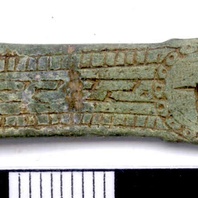
Viking Objects
Irish Strap-End (NARC-3835F4)
This Irish type strap-end is classed as Thomas Class F. The decoration consists of a zoomorphic terminal and panels of interlace. Its manufacture is possibly traced to Viking Age Dublin and is likely linked to Viking distribution of Irish artefacts. Strap-ends came in various styles and were fairly common throughout the Viking world. They were used to decorate the ends of belts and to stop them getting damaged.
Read More
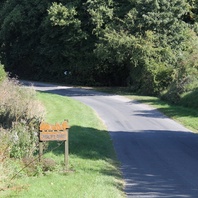
Viking Names
Ruckland
Ruckland, in the Louth Eske Wapentake of Lincolnshire, is a Scandinavian compound formed from Old Norse hrókr ‘a rook’ and Old Norse lundr ‘a small wood’.
Read More
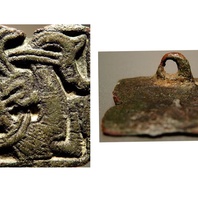
Viking Objects
Mammen-Style Square Brooch (LEIC-0BFA74)
This small brooch features a bird depicted in the Mammen style. This style of brooch appears to have been produced in the Danelaw but, generally, Mammen-style decoration is rare in Britain. This brooch from Linwood, Lincolnshire, is paralleled by examples from West Stow Heath, Suffolk, and Bergh Apton, Norfolk, but further examples from Cambridgeshire and East Anglia were found in 2015 and 2016. It is a type which has Carolingian-inspired shapes and Scandinavian decoration. Such brooches were an accessory for women who wore Scandinavian dress. For more information on Scandinavian jewellery in England check out our blog: Brooches, Pendants and Pins: Scandinavian Dress Accessories in England.
Read More
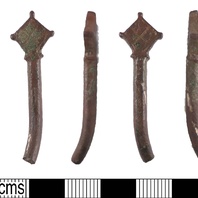
Viking Objects
Kite-Shaped Pin (PUBLIC-D9CE19)
This incomplete copper-alloy and niello pin is composed of a flat kite-shaped head with small rounded knop protrusion to three points. Both faces of the head are decorated with a cross that radiates to a narrow border and is inlaid with niello. These types of pins are generally considered to be of Irish origin and imported through Viking activities.
Read More
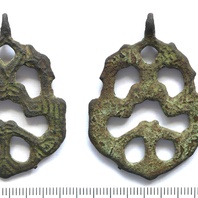
Viking Objects
Harness Pendant (PUBLIC-1FCD40)
The Ringerike-style openwork decoration on this harness pendant consists of two opposing animals with details made up of relief lines. These pendants were purely decorative elements on the harness and did not have any practical function.
Read More
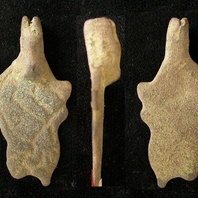
Viking Objects
Anglo-Scandinavian Strap-End (LEIC-6EDB41)
This example of an Anglo-Scandinavian copper-alloy strap-end is decorated with a possible animal head and very worn Ringerik- style interlace. It has been classed as a variant on Thomas Class G.
Read More
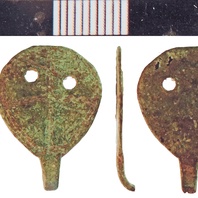
Viking Objects
Hooked Tag (NLM-7F95AB)
The function (or functions) of hooked tags is uncertain. They are small, with a plate and a sharp hook which bends to the rear. What they were stitched to or hooked into is also uncertain.
Read More
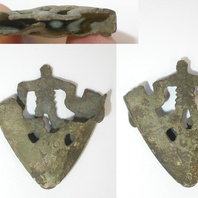
Viking Objects
Scabbard Chape (DENO-527092)
The decoration on this chape consists of a central human figure, with openwork apertures defining it, and a zoomorphic mask below.
Read More

Blog Post
Winter Camps in the East Midlands: Commerce and Industry
Viking winter camps were more than just bases for the Great Army to live in during the winter or centres from which armed Viking bands could conduct military activities. From their inception winter camps established and maintained economic functions whether as centres for trade or industry. Both Repton and Torksey were placed in a location that allowed them to take advantage of the River Trent as a means of transportation of people and goods. Repton’s evidence for trading activities is not as abundant at Torksey but finds of lead weights as well as Anglo-Saxon and Frankish coins point towards commercial activities. Evidence of industrial activities at the site includes several ship nails, include slag, woodworking tools, the tip of a Viking axe head, an area for metal working, and another area with signs of butchering of animals (Jarman 2018a, 33–34; 2018b, 20–21; Biddle and Kjølbye-Biddle 2001, 72). The nails and, perhaps, the woodworking tools could be taken as evidence for ship repair. It is also to keep in mind that the nature of extended occupation, the likelihood of camp followers, especially women, as well as the need for animals and supplies further evidences non-military activities and a larger occupation area than the fortified enclosure (Raffield 2016, 15, 21). A silver penny of Alfred the Great found at Repton, Derbyshire. (c) Derby Museums 2019 Archaeological excavations of Torksey have uncovered quite a few pieces of bullion, including hacksilver and jewellery (Raffield 2016, 313, 319; Hadley and Richards 2016, 27; Blackburn, Williams, and Graham-Campbell 2007, 71–72; Williams 2007, 183; McLeod 2014, 122–23). The relatively high concentration of gold at Torksey suggests that it was being used in transactions and not just as a status symbol which may explain the presence of hack-gold, ingots, and gold plated copper coins (Hadley and Richards 2016, 47; Blackburn, Williams, and Graham-Campbell 2007, 75–77; Blackburn 2011, 233–34). A large abundance of lead weights were also found, which are associated with merchants, with 15 resembling Scandinavian/Islamic weights from Sweden (Hadley and Richards 2016, 48; McLeod 2014, 159). Over 350 coins were also found on the site including English silver pennies, stycas from Northumbria, an imitation Frankish solidi of Louis the Pious, and 124 Arab dirhams (Hadley and Richards 2016, 43; Blackburn 2011, 225). The Arabic coins further prove just how connected the site would have been to the wider Scandinavian trade network even during the army’s years of campaigning. Hackgold Ingot fragment found in Torksey, Lincolnshire. © The Fitzwilliam Museum, Cambridge A variety of overwintering activities would have occurred at Torksey. Alongside iron clench nails, a hoard of iron woodworking nails have been discovered making it likely that Torksey would have been ideal for the repair of ships (Hadley and Richards 2016, 53–54). Additionally, worn and damaged tools were located alongside fragments of iron vessels seemingly ready to be reworked (Hadley and Richards 2016, 53). Furthermore, the discovery of spindle whorls, needles, punches and awls suggest textile-working, a job generally undertaken by women and thus providing potential evidence for a female presence at the camp (Hadley and Richards 2016, 54). These finds also suggest that overwintering activities such as the repair of sails, tents and clothing took place. Along with trading goods plundered from their campaigns, the Great Army also employed craftsmen to manufacture pottery as a tradable commodity. Evidence of pottery production at Torksey was first ascertained by excavations south of the modern village in 1949 (Perry 2016, 74). The spread of so-called ‘Torksey ware’ was vast and it even became the major pottery type at York to the point where archaeologists first assumed that it was locally made (Perry 2016, 76). An iron clench nail found near Torksey, Lincolnshire. (c) Portable Antiquities Scheme, CC BY-SA 2.0 Biddle, Martin, and Birthe Kjølbye-Biddle. ‘Repton and the “Great Heathen Army”, 873–4’. In Vikings and the Danelaw: Select Papers from the Proceedings of the Thirteenth Viking Congress, edited by James Graham-Campbell, Richard Hall, Judith Jesch, and David Parsons, 45–96. (Oxford: Oxbow Books, 2001). Graham-Campbell, James, and Gareth Williams. Silver economy in the Viking Age. (Walnut Creek, California: Left Coast Press, 2007). Hadley, Dawn M., and Julian D. Richards. “The winter camp of the Viking Great Army, AD 872–3, Torksey, Lincolnshire.” The Antiquaries Journal 96 (2016): 23-67. Jarman, C. “Resolving Repton: has archaeology found the great Viking camp.” British Archaeology (2018): 28-35. Jarman, Catrine L., Martin Biddle, Tom Higham, and Christopher Bronk Ramsey. “The Viking Great Army in England: new dates from the Repton charnel.” antiquity 92, no. 361 (2018): 183-199. McLeod, Shane. The Beginning of Scandinavian Settlement in England The Viking’Great Army’and Early Settlers, c. 865-900. (Turnhout: Brepols, 2014). Perry, Gareth J. “Pottery production in Anglo-Scandinavian Torksey (Lincolnshire): reconstructing and contextualising the chaîne opératoire.” Medieval Archaeology 60, no. 1 (2016): 72-114. Raffield, Ben. “Bands of brothers: A re‐appraisal of the Viking Great Army and its implications for the Scandinavian colonization of England.” Early Medieval Europe 24, no. 3 (2016): 308-337.
Read More
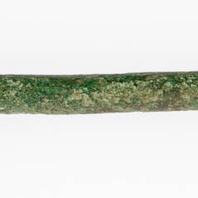
Viking Objects
Copper-Alloy Needle (CM. 1845-2008)
A cylindrical copper-alloy needle fragment with a broken shaft. Needles were a common textile tool and could be made from bone, metal or wood. They are usually associated with women and finds like this indicate that the inhabitants of the Viking camp at Torksey included women and children alongside the warriors of the Great Heathen Army.
Read More

Viking Names
Saxulf
Saxulfr is an Old Norse compound of Sax-, from either Old Norse sax ‘short sword’ or Saxar the masculine plural of ‘Saxons’, and –ulfr ‘wolf’. The mutated form Sǫxulfr appears early in West Scandinavia, but it is not very common. It is found in one Norwegian place-name, a couple of place-names in Sweden, and a number of place-names in Denmark. Saxulfr is also likely the first element of the place-name Saxilby, Lincolnshire.
